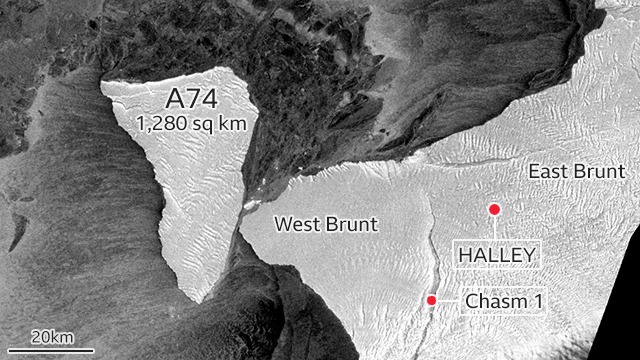The researchers aboard the Polarstern research vessel found themselves in the right place at the right time. They were sailing near Antarctica’s northern rim when a giant iceberg broke off the continent. It revealed a long-hidden world of creatures on the seafloor. The iceberg named A74 is about the size of Los Angeles. As it moved away from Antarctica, it revealed part of the seafloor that hadn’t seen sunlight in 50 years. The ship was about 3,000 miles from the southernmost tip of South America. Antarctica iceberg breaks away at the exact time, the ship is passing by. Making the news, a giant Antarctica iceberg breaks away revealing life.
The Polarstern crew waited for strong winds in the area to pass, then entered the area between the A74 and the ice shelf. The scientists’ goal: investigate the portion of the Weddell Sea bed that had been covered by up to 1,000 feet of thick ice for decades. The Polarstern crew deployed a camera instrument called the Ocean Floor Observation and Bathymetry System, or OFOBS. They towed it behind the ship on a long cable and submerged the OFOBS up to half a mile under the surface.
Most of the creatures the cameras spotted were sessile animals: organisms like anemones that attach themselves to rocks or the ocean floor and don’t move. These immobile creatures eat microscopic algae and other tiny organic particles in the water that float near their stony abodes. Using a grabbing device aboard the OFOBS, the scientists collected specimens of some of the creatures, as well as silt from seafloor. It’s a bit of a mystery what sustained this diverse underwater ecosystem in the absence of sunlight. Most organic food stuffs and algae hang out in parts of the ocean where they have access to the light they need to survive.
This isn’t the first time Antarctica has lost a giant iceberg, and it won’t be the last.
There have been many over the years that at least we know about and track. For example, Conger Ice Shelf spanning about 460 square miles. It is bigger than New York City. There is the Thwaites Glacier nicknamed the Doomsday Glacier a broad and vast glacier. One that scientist are paying extra attention too. There is the Pine Island Glacier, a huge iceberg that broke off west Antarctica’s ice shelves. Antarctica is an ever-changing landscape. In some regions it is losing ice levels, while it seems to be gaining in other regions.
What life is still to be discovered is hard to tell. It is after all a region not well explored. Antarctica is a none forgiving land. A treacherous place, full of danger and mystery. We know very little about the continent. What else will it take for us to discover life there. A giant Antarctica iceberg breaks this time, what next? Civilization that lived there are not known to at least the public. Any history about life and events there are not discussed. Antarctica remains a distant, strange, and mysterious place. Much like when we discovered it. The public knows not much about the life in Antarctica. Maybe one day, we will discover ancient civilizations that have made the continent their home. Want to read a mystery about Antarctica? Try Arctic Ave, a great mystery thriller by Daniel River. You can read the first chapter on this website.







